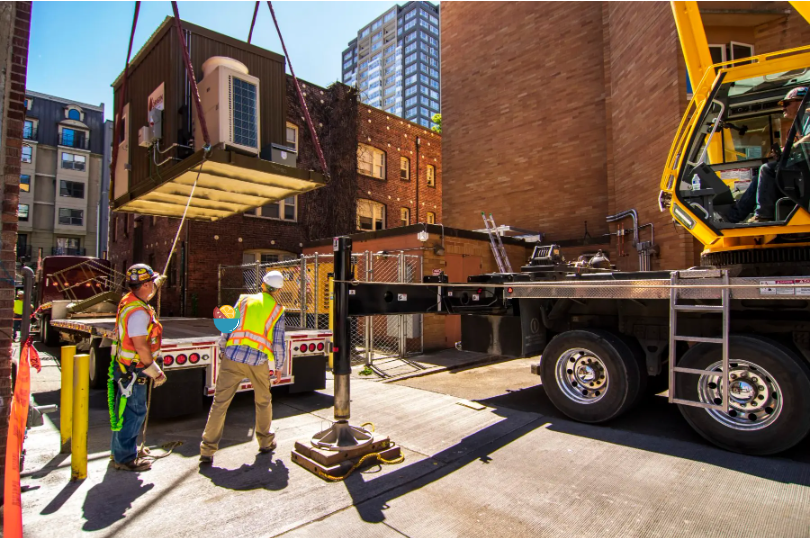Bayview Tower is a low-income public housing facility for senior citizens located in downtown Seattle. Hot water for the residents of Bayview was provided by an inefficient electric resistance water heater that used a lot of electricity to heat water. In 2019, a dream team of organizations that included Ecotope, Seattle Housing Authority, Bonneville Power Administration, Steffes, SkyCentrics, Mitsubishi, and Seattle City Light came together to retrofit the building with a central heat pump water heater (CHPWH) that had the potential to reduce the energy used to heat water, which accounts for about 25-35% of the average multi-family building’s energy usage, by a factor of three.
Central heat pump water heaters are different from their residential cousins in ways you would probably expect. Instead of having individual water heater tanks in every home and apartment, central systems are much larger and provide hot water to many households at once. In the case of Bayview, one system serves 100 apartments. Nationally, there have been hundreds of CHPWHs installed to date, but this technology is still early in its adoption.
The central heat pump water heater installed at Bayview broke lots of new ground and is proving many important concepts which could help guide how we heat water in these upcoming crucial decades for decarbonization. First off, the CHPWH for Bayview was a packaged, skid mounted (meaning it is permanently mounted on a metal pallet) system with many components that were manufactured off-site and then delivered by crane to the building, more or less ready to plug into place. The “plug’n play” nature of this water heater meant Bayview Tower residents experienced only a couple hours of hot water downtime while a whole new water heating system was installed. The water heater was installed in the summer of 2021 and the system has now been operational for a year and half, meeting the residents’ hot water needs while saving an estimated 135,000 kilowatt hours (kWh) annually along with significantly reducing CO2 emissions and electricity bills.

Treating A Water Heater Like a BatteryAfter the CHPWH system was installed and proved its ability to work well, the team moved into phase two of the project, which sought to prove that CHPWHs can provide significant load shifting capacity. As communities, regions and states electrify buildings and transportation and move to use more solar and wind generated energy, the times we use electricity become increasingly important. If everyone uses lots of electricity at the same time (during morning and evening peak periods for example) utilities must rely on fossil fuel powered plants to provide the extra supply, or in worst case scenarios cut some power to homes. Using less electricity, storing electricity in batteries, and spreading out or shifting our energy usage are key strategies to help solve this problem.
The nonprofit I work for, New Buildings Institute, has been working on building-scale solutions to enable grid decarbonization through the GridOptimal Buildings Initiative for over three years now and has consistently found that water heating systems are a silver bullet technology for load shifting and grid integration. Because water can hold a lot of energy, you can use it like a battery — “charge” the system by using the efficient heat pump to heat water up during times of low grid demand (or high renewable production), and then use that stored energy during times of high grid demand while still enjoying plenty of hot water. Water heaters in multi-family and commercial buildings can be important players because they have more water storage capacity concentrated in one system.
The team working on the Bayview tower project spent the last several months piloting an approach to preheat the water heater hotter than normal during low demand periods, and then turn it off between typical periods of peak usage from 6:00-9:00 AM and PM. And as the chart below indicates, it worked. The blue line shows the baseline heat pump water use without any load shifting. The red line shows how they’ve been able to turn off the system during times of peak demand (while continuing to provide all the hot water necessary) and compares it to what energy usage would look like (green line) with the previous electric resistance water heater.

Total energy usage shows another side of these energy savings. Before installing the CHPWH, the building would typically use between 70-75 kWh of electricity during times of peak usage (blue bars). After installing the more efficient CHPWH and starting with typical settings, that usage was cut by 60% (red bars). Switching the water heater to preheat water in non-peak times in the latest phase of this pilot shows that buildings can essentially cut the energy used during peak times to near zero (green bars).

And this represents a tremendous opportunity at a system level. The amount of power capacity that could be saved if nearly all apartment buildings in California were converted to run on load shifting heat pump water heaters is estimated at 2,000 MW. During times of peak demand, cutting 2,000 MW of power could take a significant chunk off the top of the peak energy usage in California (and is actually about as much energy as Californians were able to trim during last summer’s emergency heat wave) – the time when fossil fuel power plants are most likely to be needed. The impact of this shift is shown in the figure below.

Bayview Tower thus shows how central water heaters hold a vast potential to act as a type of battery, providing more efficient water heating during times of normal operation and completely shifting the times when energy is used for water heating, enabling the same comfort and hot water while ensuring a more efficient and greener grid.